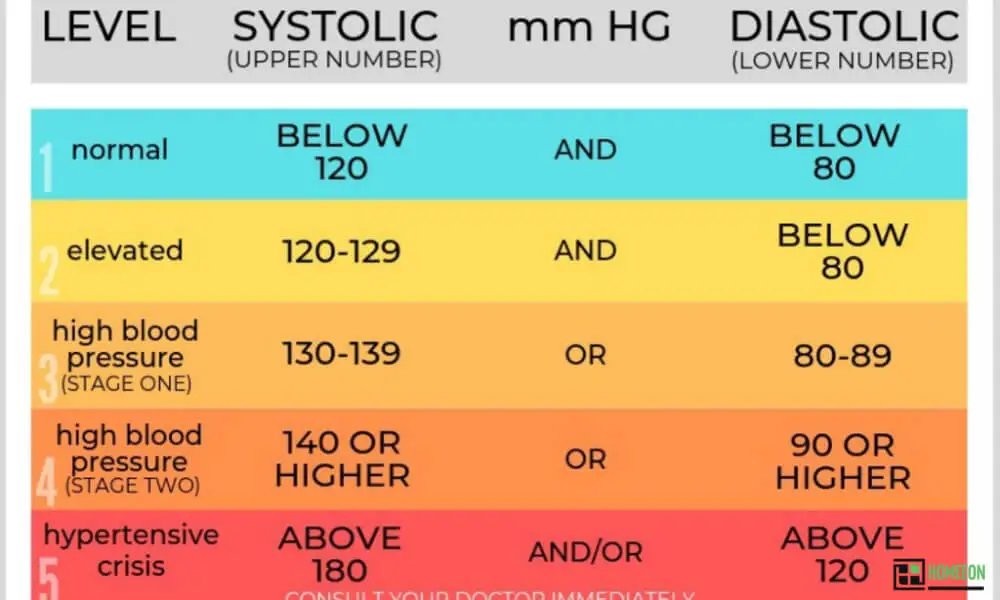Last Updated on July 16, 2023 By Emma W. Thomas
A blood pressure chart by age and gender provides reference ranges for normal blood pressure levels based on age and sex. Generally, blood pressure tends to increase with age due to factors like lifestyle and health conditions. For adults, a normal blood pressure reading is around 120/80 mmHg. However, as people age, higher readings might be considered normal. In older adults, systolic pressure of 130-139 mmHg and diastolic pressure of 80-89 mmHg may be acceptable. Women typically have slightly lower blood pressure than men until menopause when it often increases.
The Following Chart Shows The Average Blood Pressure By Age And Gender.
Age bracket | Systolic blood pressure | Diastolic blood pressure | |
Female | |||
61-65 years | 130.5 | 77.5 | |
| 56-60 years | 132.5 | 78.5 | |
| 51-55 years | 122.5 | 74.5 | |
| 46-50 years | 124 | 78.5 | |
| 41-45 years | 116.5 | 73.5 | |
| 36-40 years | 112.5 | 74.5 | |
| 31-35 years | 110.5 | 72.5 | |
| 26-30 years | 113.5 | 71.5 | |
| 21-25 years | 115.5 | 70.5 | |
| Male | |||
| 61-65 years | 143.5 | 76.5 | |
| 56-60 years | 129.5 | 79.5 | |
| 51-55 years | 125.5 | 80.5 | |
| 46-50 years | 119.5 | 80.5 | |
| 41-45 years | 115.5 | 78.5 | |
| 36-40 years | 120.5 | 75.5 | |
| 31-35 years | 114.5 | 75.5 | |
| 26-30 years | 119.5 | 76.5 | |
| 21-25 years | 120.5 | 78.5 |
What Do Blood Pressure Numbers Mean?
Understanding blood pressure numbers is crucial for monitoring heart health. Blood pressure readings consist of two numbers, which represent the force exerted by your blood on the walls of your arteries. By recognizing what these numbers mean, you can take the necessary steps to maintain a healthy blood pressure range. Let’s dive deeper into the significance of blood pressure numbers!
Systolic Pressure (Top Number):
- The top number in a blood pressure reading is known as the systolic pressure.
- It measures the force exerted on artery walls when the heart contracts and pumps blood.
- Systolic pressure is typically noted as the higher value in a blood pressure reading.
- Normal systolic pressure for adults is around 90-120 mmHg (millimeters of mercury).
Diastolic Pressure (Bottom Number):
- The bottom number in a blood pressure reading is the diastolic pressure.
- It indicates the force exerted on artery walls when the heart rests between beats.
- Diastolic pressure is usually noted as the lower value in a blood pressure reading.
- Normal diastolic pressure for adults is about 60-80 mmHg.
What Are The Various Categories Of Blood Pressure?
Blood pressure can be classified into five categories, i.e. Normal, elevated, hypertension stage I, hypertension stage II, and hypertensive.
Normal Blood Pressure
Normal blood pressure should be below 120/80 mm Hg for an adult.
Elevated Blood Pressure
Your blood pressure is considered elevated if its systolic readings range from 120 – 129 mm Hg and the diastolic readings are less than 80 mm Hg consistently. Unless proper control steps are taken, elevated blood pressure could lead to high blood pressure.
Hypertension Stage I
This type of blood pressure is when the systolic readings range between 130 mmHg to 139 mmHg. On the other hand, the diastolic readings are between 80 mm Hg to 89 mm Hg consistently. A person with this kind of blood pressure may have their doctor prescribe some lifestyle changes and medications. Doing this helps to avert the risk of stroke and also heart diseases.
Hypertension Stage II
If your blood pressure consistently reads 140/90 mm Hg or higher, you have stage II hypertension. Your doctor can prescribe both lifestyle changes and medication to help regulate the blood pressure.
Hypertensive Crisis
This blood pressure condition is critical and requires immediate medical attention. The blood pressure readings may suddenly rise beyond 180/120 mm Hg with a hypertensive crisis. In case you experience the following symptoms, you need to seek urgent medical attention;
- Difficulties in breathing or shortness of breath
- Back or chest pain
- Feeling weak or numb
- Blurred vision
- Problems with speech
What Are The Common Symptoms Of High Blood Pressure?
While some people may experience some symptoms of high blood pressure, others may have no signs at all. For this reason, hypertension has been perceived as a ‘silent killer’. If hypertension persists for long, it can lead to severe complications such as stroke, kidney disease, or even heart attack. Some people may experience the following signs of high blood pressure;
- Headache
- Feeling dizzy
- Nausea
- Pulsations in the head or neck
- Blurred vision
- Shortness of breath
How Can You Treat High Blood Pressure?
High blood pressure may be treated through regular exercise and lifestyle changes. Physicians suggest the following lifestyle changes;
- Losing excess weight
- Quitting smoking
- Minimize or stop the intake of alcohol
- Reduce stress
- Eating a low-fat and low-sodium diet
- Eating food rich in magnesium, potassium, and calcium like milk and bananas.
- Engage in stress-relieving exercises and practice meditation
- Minimize the intake of caffeine
- Monitor your blood pressure regularly once you get to the age of 35 years.
A physician may also prescribe some medications such as;
- ACE inhibitors
- Diuretics
- Vasodilators
- Calcium channel blockers
- Beta-blockers
- Alpha-blockers
How Can One Prevent Or Treat Low Blood Pressure?

The following methods can help you to treat or prevent low blood pressure;
- Minimizing or stopping alcohol intake
- Consuming a lot of fluids
- Consuming a lot of non-alcoholic drinks
- Ensure that you remain hydrated when the weather is hot or when there is an outbreak of viral flu
- Be sure to exercise often. Doing this helps to enhance blood circulation
- sitting or standing very fast
- When getting out of the bed, start by sitting upright for a while before getting out of the bed.
- lifting heavy objects.
- Make sure that you do not strain while passing stools
- Do not expose yourself to hot water for a prolonged period. This hot water includes hot water springs, sauna, and spas
- Do not stand still for long
- Eat little meals more frequently to prevent post-meal dizziness
- Avoid the use of over-the-counter medications without informing your physician
A physician could prescribe the following remedies to treat low blood pressure;
- midodrine
- fludrocortisone
What Are Some Risk Factors For High Blood Pressure?
There are several risk factors for high blood pressure, including;
Obesity Or Being Overweight
Being obese or having excess weight means that you require more blood flow to help supply nutrients and oxygen to the body tissues. An increase in blood volume inside the vessels leads to increased pressure in the arteries.
Excess Salt In Your Food
Excess salt in your diet means a lot of sodium, which leads to the retention of fluid in the body. It also leads to constriction of the arteries in the body. Such factors cause an increase in blood pressure.
Inadequate Amount Of Potassium In Your Diet
Your diet needs to have enough potassium to enhance blood flow in the arteries by balancing sodium in the cells. If your diet has sufficient potassium, it helps the muscle cells in the arteries to relax. Relaxed muscle cells lower your blood pressure.
Some of the primary sources of potassium include;
- Dried fruits such as apricots and raisins
- Beans, lentils, potatoes
- Winter squash such as butternut and acorn
- Avocadoes, bananas, oranges, orange juice
- Tomatoes, coconut water
- Chicken and salmon
- Yoghurt, dairy, and plant milk such as soy and almond
Being Physically Inactive
Physical exercises help to enhance blood circulation through the body’s arteries. The increased blood flow causes the body to release natural cytokines and hormones that help the blood vessels to relax. As a result, the relaxed vessels lead to lower blood pressure. A person who is not physically active may become overweight, which may lead to high blood pressure.
Stress

A high level of stress is a significant risk factor for high blood pressure, and one needs to minimize it as much as possible. You may engage in medication and try to relax as much as you can to reduce stress and, in return, lower the blood pressure.
Too Much Intake Of Alcohol
Alcohol may activate the adrenergic nervous system, leading to constriction of blood vessels. It can also lead to increased heart rate and blood pressure. If you must drink, let it not exceed two drinks per day.
Use Of NSAIDs Drugs
Some NSAIDs (Non-steroidal Anti-inflammatory Drugs) such as ibuprofen, Motrin, Advil may worsen existing hypertension. It could also cause new cases of hypertension. These drugs may also damage the kidneys, cause heart failure, stroke, or heart attack. Other NSAIDs drugs include;
- Naproxen (Naprosyn, Aleve, Anaprox)
- Sulindac (Clinoril)
- Diclofenac (Voltaren)
- Piroxicam (Feldene)
- Indomethacin (Indicin)
- Mobic, Lodine
- Celecosib (Celebrex)
Cold And Cough Medications Containing Phenylephrine And Pseudoephedrine
Some of the medicines used to treat coughs and colds contain decongestants. These decongestants, such as phenylephrine and pseudoephedrine, may increase heart rate and blood pressure since they constrict the arteries.
Inadequate Amount Of Vitamin D In The Diet
Although it is not clear whether an insufficient amount of vitamin D in the diet causes high blood pressure, some researchers feel it has adverse effects. Your kidneys produce Vitamin D, an enzyme that affects blood pressure. Some more research is necessary to establish the role of this vitamin in blood pressure.
Some Chronic Conditions
Some chronic conditions such as kidney disease, sleep apnea, and diabetes are also likely to increase blood pressure.
Age
As one gets older, the risk of blood pressure also increases. Hypertension (high blood pressure) is more common in men up to the age of 64, but it is likely to appear in women after 65.
Your Race
Hypertension is more prevalent in some races than others. For example, people of African heritage can develop high blood pressure earlier in life than whites. It is also more common for Africans to get kidney failure, heart attack, and stroke than other races.
What Are Some Complications Related To Hypertension?
Hypertension can lead to several complications, including;
- Stroke or heart attack
- Weak and narrowed blood vessels in the kidneys
- Aneurysm
- Heart failure
- Narrow, thickened, or torn blood vessels in the eyes
- Metabolic syndrome
- Dementia due to decreased blood flow in the brain
- Loss of memory or trouble with understanding
Conclusion
Blood pressure is considered normal when less than 120/80 mm Hg. Any value/level higher than this is called high blood pressure, and it calls for attention. Since higher blood pressure puts one at risk of other health issues such as heart attack, heart disease, and stroke, it is good to consult your doctor. The physician may recommend some lifestyle changes, medications, or both.
It is also advisable to have your blood pressure checked regularly after one attains the age of 18 years and above.
References:
https://www.baptisthealth.com/blog/heart-care/healthy-blood-pressure-by-age-and-gender-chart
https://www.verywellhealth.com/average-blood-pressure-by-age-5085328
Emma is a graduate of Domestic Science or Family and Consumer Sciences (Home Economics) from the University of Wisconsin. She has 7 years of experience Working with the strategic section of BestBuy and now writing full-time for Homeeon.
From Managing the Home, Interiors, Cleaning, and Exteriors to Gardening and everything about Making A Home Liveable – is her passion and this Homeeon is the result of this.
Emma loves decorating her home with the best stuff found online. She cares about quality over anything and writes reviews about them here in Homeeon. Get in touch with her over Pinterest.
Keep reading her blogs.

